The
first issue of Sardinia Kingdom appeared January 1st 1851. The printing was
made in lithography in sheets of 50 pieces (2 groups of 25) despite the Postal
Administration desire was to have a stamp "engraved".
As I explained in the general introduction of the issue (please refer to the
intro for other details here left out), the preparation system of the printing
plates was not constant in time; at the beginning Matraire duplicated the
matrix as many times as many were the stamps and therefore 25 duplications
for each of the two groups of 25 of the sheet. This approach provided a printing
very much detailed and sharp, typical of the first issues. Later on it was
prepared an unique composition of 25 pieces without starting from the original
matrix. From this new "stone", that was kept as "main stone",
were obtained in sequence some other stones for the various issues and prints,
carrying the entire block in a single step and decreasing in this way the
work time. Every time a new duplication of the block was done, the result
was different from the original stone due to the inaccuracy of the methodology
used. The study of these small (and often not so visible) details allows for
the reconstruction of the various duplications in time.
With time and numbers of duplications the printing quality became worse and
worse.
The complete study of the duplications and of the following issues is not
yet fully completed; only for the 20 centesimi value it can be considered
finished; for the 5 and 40 centesimi, also for the difficulty to find these
rare stamps in quantity several doubts are still there on the number and sequence
of the duplications.
I will present the known data until this time, with more details, of course,
for the 20 centesimi.
Unfortunately I don't have so many scans and the images on the books are almost
always very poor; I will be grateful to everyone who can make available images
of "sure" parts when I don't have scan of them (unfortunately are
a lot...) or may be when the images are better than the ones I have.
5 CENTESIMI
We can summarize the sequence of the plates and duplications as follows:
|
1st
PRINTING
It was made by using 5 different plates that differ by very small details, specially at the level of alignment between stamps and color shades, that I will not deal with in this place: it is in general characterized by a printing very sharp and reach of details; the color is quite dark or through a grayish and the alignment between the various pieces is very irregular; vertical distance very much reduced, small pearls of the frame very visible; sometimes it's possible to note some small color traits in the white spaces between the stamps (Fig. 1). |
|
1st
DUPLICATION
Color hole of triangular shape in the upper border of the bottom left curved triangle, over the first "C", slightly through the right; pieces of this duplication are somehow rare. |
|
2nd
DUPLICATION
Close to the nape of the royal effigy, close to the "C" of "FRANCO" the profile is interrupted by a color spot; the internal oval frame has an interruption close to the first "O" of "BOLLO"; the label "C. POSTE 0.5" (specially the "5") is often not detailed; frequent color lines in the white margins between the various stamps (Fig. 2). |
|
3rd
DUPLICATION
The internal oval frame is thicker close to the letters "RA" of "FRANCO"; under the "C" of "POSTE" often there are color spots in the white horizontal row; color spot that penetrates the upper left triangle; after the "O" of "FRANCO" some color traits are present in the white spaces between the stamps even if split; printing not so sharp; pieces of this duplication are somehow rare (Fig. 3). |
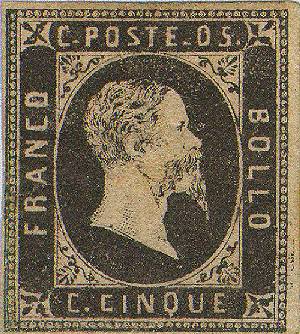
Fig. 1: the typical printing sharp and detailed of the first issue
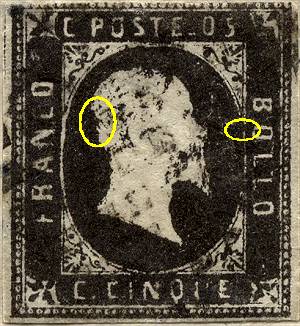 |
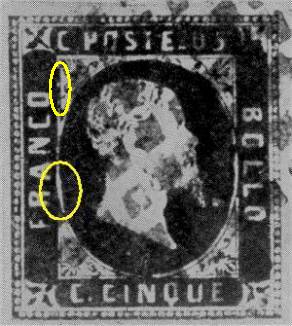 |
|
Fig.
2: the 2nd duplication
|
Fig.
3: the 3rd duplication
(from "Filatelia" nbr. 20 dated 25/03/1965) |
20 CENTESIMI
We can summarize as follows the sequence of plates and duplications:
|
1st
PRINTING
It was made by using 4 different plates that differ by very small details especially at level of alignment between stamps and color shades that I will not deal with in this place. It is generally characterized by a printing very sharp and reach of details, small pearls very visible; sometimes a white color dot is present between the "E" and "N" of "VENTI"; white dot not always visible under the "P" of "POSTE"; central oval is continuous without any interruption (Fig. 4). |
|
1st
DUPLICATION
White oval interrupted by a color dot in the bottom lower part; color dot in the upper triangle, under the right curl (sometimes is found in the first printing-run too); the left curl of the ornament of the upper right corner is full of color; the left white vertical line is broken just under the "F" of "FRANCO" (it is possible sometimes also in the first printing run). Small color trait in the upper left triangle, to the left under the "C" of "POSTE". |
|
2nd
DUPLICATION
Central oval interrupted at bottom right by a color trait, close to the "N" of "VENTI"; internal white oval interrupted at the bottom center' more distance between samples versus the previous values that are enough close to each other; these pieces are somehow rare. |
|
3rd
DUPLICATION
Oval interrupted close to the "V" of "VENTI" and between "E" and "N" of "VENTI again; under the small white trait between "POSTE and "20" is noticeable a small color trait; the left curl of the ornament of the upper right corner is full of color (Fig. 5). |
|
4th
DUPLICATION
Interruption of the central oval over the "E" of "VENTI", slightly to the right; printing sharp at the beginning and very poor later on, specially in the last printing runs with this duplication; attention not to confuse this duplication with the previous ones (Fig. 6). |
|
5th
DUPLICATION
"E" of "VENTI" resembling an "F" (defect corrected later on with an intervention); "N" of "FRANCO" without the upper part f the left leg; "T" of "VENTI" with left part of the horizontal trait just visible or missing; white dot between "E" and "N" of "VENTI" (as for the first printing run) and sometimes other white spots under the lower label (defects later on corrected); printing very bad. These parts are rare (Fig. 7). |
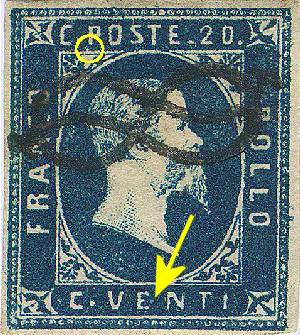
Fig.
4: the typical appeatance of the first printing
run
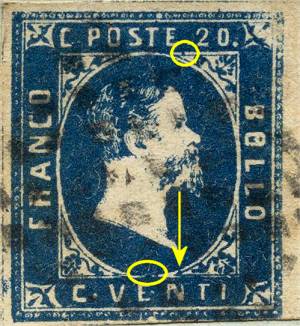 |
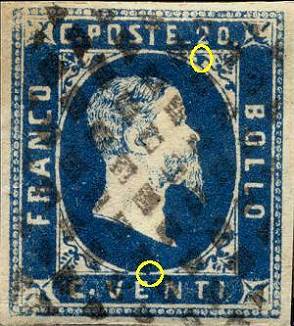 |
|
Fig.
5: the 3rd duplication
|
Fig.
6: the 4th duplication
(Attention: do not get confused with something else!) |
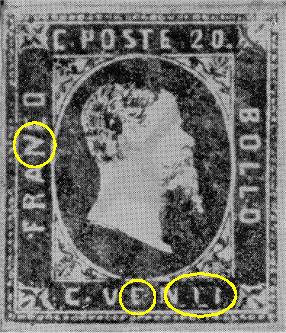
Fig. 7: the 5th duplication
(from "Filatelia" nbr. 21 dated 25/04/1965)
40 CENTESIMI
The
difficulty to find abundant material of this value has not yet allowed
to give a definitive picture of its duplications; as for the previous
samples, the pieces of the first issue (whose used tables are still unknown)
are recognized for the great precision of printing in any detail; colors
are generally through a vivid rose carmine.
The number of later on duplications is unknown, but it is believed that there
are al least two duplications; printings of these duplications are less sharp
than in the first pieces.